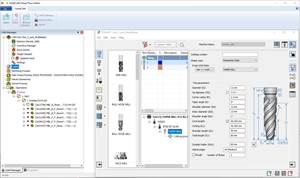What CAM Functions Do Moldmakers Want?
In development of CAM software products, vendors must establish priorities and allocate resources accordingly. The priorities are primarily determined by the market or markets they wish to serve and the product's user.
In development of CAM software products, vendors must establish priorities and allocate resources accordingly. The priorities are primarily determined by the market or markets they wish to serve and the product's user. For example, aerospace users typically require a strong simultaneous five-axis capability, production machining users need effective support for multi-functional machines such as mill-turns, and moldmakers want strong three-axis milling functionality.
CIMdata surveyed moldmakers worldwide to learn which product functions they deemed most important. Twenty-one functions were defined, and moldmakers were asked to rate their importance on a scale of 1 to 5, with 5 being the most important.
The results of the survey confirmed the commonly accepted view that a strong three-axis milling capability is the most important of the 21 defined functions. It had a rating of 4.6 on the 5.0 scale. This is not surprising, since a large fraction of molds contain complex surfaces, and these are typically cut on three-axis milling machines. Further, three-axis milling is usually the most time- consuming and critical element in the mold machining process.
Because three-axis milling is the most important NC programming function in moldmaking and a broad function, CIMdata further defined 18 individual features that are generally considered important within three-axis milling and then asked moldmakers to rate these features. The results indicate that the four most important three-axis milling features, listed in order of importance, are effective gouge avoidance, support of high-speed machining, programming flexibility and automatic rest machining. The average importance ratings for these four features ranged from 4.1 to 4.4.
Given the high cost to produce most molds, effective gouge avoidance is a fundamental requirement, and it is viewed as the most important feature. The use of high speed machining by moldmakers to improve surface finishes and reduce overall shop time is becoming commonplace, and support of this capability is essential for CAM vendors focused on the mold marketplace. Because users like programming flexibility and want to remain in control of the machining process, flexibility is also considered an important feature. Elements of programming automation such as automatic rest milling, in which a toolpath is automatically generated to remove material that was left behind from a previous cut, have gained acceptance.
At the other end of the scale, machining of STL files was the programming feature rated least important, as it garnered an average rating of 2.8.
In the overall functional ranking, strong roughing ranked second to three-axis milling with a 4.4 rating, and tight integration with design software came third with a 4.2 rating. Roughing is a major function that often consumes a significant portion of the overall machining time. A number of newer roughing techniques are now being employed, including rest roughing to remove uncut material and plunge roughing to remove more material in a shorter period of time. Tight integration with design generally implies associativity between creating a model and NC programming. As design changes occur, associativity often permits users to quickly and automatically regenerate a toolpath to accommodate the design change, saving programming time.
Overall worldwide rankings were driven primarily by North American and Japanese moldmakers. European moldmakers considered all three functions important but ranked them differently. They deemed integration of machining with design most important, followed by strong three-axis milling and strong roughing.
Further, European moldmakers chose differently when ranking more detailed 3-axis milling features. At the feature level, their order of importance among the top four worldwide features was support of high speed machining, programming flexibility, effective gouge avoidance and automatic rest machining.
At the lower end of the scale, overall software functions with average importance ratings of less than 3.0 include support of PDM software, support of CMM machines and strong simultaneous five-axis milling. However, CIMdata believes that the importance of each of these functions will increase in time. PDM software is rapidly gaining acceptance in manufacturing companies, and this will likely spread throughout the supply chain. Quality management systems are gaining acceptance, and CMM machines are a component of a quality program.
Lastly, CIMdata believes use of simultaneous five-axis machines in mold shops is increasing in as the price of the machine tool falls, programming becomes easier and the benefits of its use become better established.
Related Content
Automated CAM Programming – Is Your Software Really Delivering?
A look at the latest automation tools in Autodesk Fusion 360 software and how forward-thinking machine shops and manufacturing departments are using them to slash delivery times and win more business.
Read MoreHow this Job Shop Grew Capacity Without Expanding Footprint
This shop relies on digital solutions to grow their manufacturing business. With this approach, W.A. Pfeiffer has achieved seamless end-to-end connectivity, shorter lead times and increased throughput.
Read MoreCan ChatGPT Create Usable G-Code Programs?
Since its debut in late 2022, ChatGPT has been used in many situations, from writing stories to writing code, including G-code. But is it useful to shops? We asked a CAM expert for his thoughts.
Read MoreBuilding A Powerful Bridge from the CAM Programmer to the Shop Floor Operator
SolidCAM for Operators provides a powerful bridge from CAM programming to the shop floor to best streamline the machine shop process with its CAM part simulation. It provides a clear picture to the operator for setup and prove-out, enables minor G-Code changes and avoids crashes, broken tools and scrapped parts.
Read MoreRead Next
3 Mistakes That Cause CNC Programs to Fail
Despite enhancements to manufacturing technology, there are still issues today that can cause programs to fail. These failures can cause lost time, scrapped parts, damaged machines and even injured operators.
Read MoreThe Cut Scene: The Finer Details of Large-Format Machining
Small details and features can have an outsized impact on large parts, such as Barbco’s collapsible utility drill head.
Read More












.png;maxWidth=300;quality=90)









